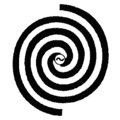Engineering:Self-complementary antenna
The self-complementary antenna (SCA) is a basic antenna for extremely broadband practical antennas.[1][2][3][4] This antenna[5][6] is an arbitrarily shaped antenna which is constituted with a half of an infinitely extended planar-sheet conductor such that the shape of its complementary structure is exactly identical, or "self-complementary"[7] with that of the original structure with two terminals for the simplest case. The self-complementary antenna has constant input impedance[8][9] independent of the source frequency and the shape of the structure.
The type of the self-complementary antenna is not limited only to the case of a planar antenna with two terminals, but there are more general types with various grades of complexity, such as, the number of terminals, the number of reference planes, and others. Moreover, there is infinite freedom in their shapes of the structures.[10] They also have constant-impedance property independent of the source frequency and the shape of the structure for respective classes of structures with various grades of complexity. This general principle of self-complementarity is also called the "Mushiake Principle" by various sources.[11]
Examples for two shapes of the structures are shown in the attached figures. The structures 1 to 3 are for square shape,[12] and the structures 4 to 6 are spiral shape. Actually, the structures extend infinitely, but the figures show only finite portions near the feed point of each structure.
The equation which gives the constant value of the input impedance for self-complementary antenna is called the "Mushiake Relationship". The values of the constant-impedance for various classes of complexity in the self-complementary structures depend on the respective grades of the complexity. For example, the Mushiake relationship for the simplest self-complementary planar antenna with two terminals is expressed as:
Z = Z0/2≒188.4 [Ω], (Mushiake relationship)
where Z is the input impedance of the antenna, and Z0 is the intrinsic impedance of the medium.
Moreover, experimental studies on self-complementary antennas, including radiation properties, are conducted in Japan. As the results of the experiment, it is found that the truncated alternate-leaves type self-complementary antenna (or Square SCA) has practically omnidirectional radiation pattern[13] as well as the broadband property.
Comparison with log-periodic antennas
The log-periodic antenna is a modified, folded up, square self-complementary antenna with log-periodic shape, and the original structure before its modification has a typical self-complementary shape. The log-periodic shape does not provide the broadband property for antennas.[14] This fact is experimentally proven.[15] It is also evident from the IEEE definition of "Log-Periodic Antenna".[16] The "Log-Periodic Dipole Array"[17] or "Log-Periodic Dipole Antenna"[18] (LPDA), is a practically modified self-complementary antenna. LPDA has transposed excitation[19] for the dipole array resulted from folding up[20] the antenna structure to obtain unidirectional radiation, that is inevitable outcome of the modification.
In connection with the book Self-complementary Antennas published at the Springer-Verlag in London, is mentioned here,Springer Book Archives[21] should be shown around here.
The log-periodic structure failed to provide constant-impedance property for antennas over one period. However, one certain way to eliminate such variation is to make the shape self-complementary,[22] and the expression for the constant impedance is called "Mushiake's relation" by V. H. Rumsey.(Recently it is called〝Mushiake relationship".)
Accordingly, LPDA is actually a Modified Self-complementary Dipole Array (MSCDA) with log-periodic shape. Where the self-complementary shape has infinite freedom [23] and further evolution is expected for general type of broadband dipole array, MSCDA. For example, with recent widespread Wi-Fi utilization, this type of broadband MSCDA is found, including so-called LPDA, at the Wi-Fi access points.
Furthermore, "Discovery of the Principle of Self-Complementarity in Antennas and the Mushiake Relationship, 1948" was recognized as IEEE Milestone July 2017, without mentioning the needless term "log-periodic shape" for that recognition. Moreover, to be proposed as an IEEE Milestone, an achievement must be at least 25 years old, have benefited humanity, and must have had at least regional importance. This IEEE Milestone was dedicated to Tohoku University, Japan, and detailed explanation can be found in the List of Milestones,[24] or more easily found in.[25] In addition, a noun "Milestone" means "a very important stage or event in the development of something", and "Landmark" is its synonym. Source is,[26] Oxford University Press, 2015.
See also
References
- ↑ D. E. Isbell, "Log-periodic dipole arrays" IRE Trans. Antennas Propag., vol. AP-8, pp.260-267, May 1960.
- ↑ R. L. Carrel, "The design of log-periodic dipole antennas," IRE Intl. Conv. Rec., pt. 1, pp. 61-75, 1961
- ↑ Y. Mushiake, Log-periodic structure provides no broad-band property for antennas. J. IECE Japan, 82, No 5, pp. 510-511, May 1999. (in Japanese)
- ↑ Y. Mushiake, "A report on Japanese developments of antennas: From the Yagi-Uda antenna to self-complementary antennas", IEEE Ant. Prop. Magazine, Vol. 46, No. 4, pp. 47-60, August 2004
- ↑ "Y. Mushiake, "The input impedances of slit antennas," J. IEE of Japan, Vol. 69, No. 3, Cumulative No. 725, March 1949. pp. 87-88. (in Japanese)". Sm.rim.or.jp. http://www.sm.rim.or.jp/~ymushiak/sub.docu.1.htm. Retrieved 2014-01-07.
- ↑ S. Uda, and Y. Mushiake, "The input impedances of slit antennas," Tech. Rep. of Tohoku Univ., 14, 1, September 1949. pp. 46-59.
- ↑ "Y. Mushiake, "Origination of self-complementary structure and discovery of its constant-impedance property." J. IEE of Japan, Vol. 69, No. 3, March 1949. p. 88. (in Japanese)". Sm.rim.or.jp. http://www.sm.rim.or.jp/~ymushiak/sub.docu.1.htm##%%. Retrieved 2014-01-07.
- ↑ Y. Mushiake, "The input impedances of slit antennas," J. IEE Japan, 69, 3, March 1949. pp. 87-88. (in Japanese)
- ↑ Y. Mushiake, "Constant-impedance antennas," J. IECE Japan, 48, 4, April 1965. pp. 580-584. (in Japanese)
- ↑ http://www.sm.rim.or.jp/~ymushiak/sub.sca.htm
- ↑ Ranjan Singh, et al; Spiral-type terahertz antennas and the manifestation of the Mushiake principle, OSA Publishing, Optics Express, Volume 17, Issue 12, Page 9971-9980, (2009)https://www.osapublishing.org/abstract.cfm?uri=oe-17-12-9971,
- ↑ T. Furuya, T. Ishizone, and Y. Mushiake, "Alternate-leaved Self-complementary Antenna and Its Application to High Gain Broadband Antenna", IECE (presently IEICE), A・P, 77-43, 1977, pp. 35-40. (in Japanese)
- ↑ http://www.sm.rim.or.jp/~ymushiak/sub.omni.square.htm
- ↑ Y. Mushiake, "Constant-impedance antennas," J. IECE Japan, 48, 4, pp. 580-584, April 1965
- ↑ "Fig. 2: A comparison of the measured input resistances". http://www.sm.rim.or.jp/~ymushiak/sub.non-const.htm#####.
- ↑ "Log-periodic antenna Any one of a class of antennas having a structural geometry such that its impedance and radiation characteristics repeat periodically as the logarithm of frequency."(see The new IEEE Standard Dictionary of Electrical and Electronics Terms,1993).
- ↑ D. E. Isbell, "Log-periodic dipole arrays" IRE Trans. Antennas Propag., vol. AP-8, pp.260-267, May 1960.
- ↑ R. L. Carrel, "The design of log-periodic dipole antennas," IRE Intl. Conv. Rec., pt.I, pp. 61-75, 1961
- ↑ "Y. Mushiake, Self-Complementary Antennas—Principle of Self-Complementarity for Constant Impedance—, 139 pages, Springer-Verlag London Ltd., London,1996.pp.75-80". Sm.rim.or.jp. http://www.sm.rim.or.jp/~ymushiak/sub.4.htm. Retrieved 2019-12-13.
- ↑ http://www.sm.rim.or.jp/~ymushiak/sub.4.htm#%%#
- ↑ http://www.sm.rim.or.jp/~ymushiak/sub.springer.htm
- ↑ V. H. Rumsey, Frequency independent antennas, Academic Press, New York and London. 1966. [pp. 27, 29, 30, 55]
- ↑ http://www.sm.rim.or.jp/~ymushiak/sub.sca.htm
- ↑ http://ethw.org/Milestones:List_of_Milestones Dedication # 180
- ↑ "Milestones:The Discovery of the Principle of Self-Complementarity in Antennas and the Mushiake Relationship, 1948 - Engineering and Technology History Wiki". 3 November 2021. https://ethw.org/Milestones:The_Discovery_of_the_Principle_of_Self-Complementarity_in_Antennas_and_the_Mushiake_Relationship,_1948.
- ↑ Oxford advanced learner's dictionary of current English
 |








